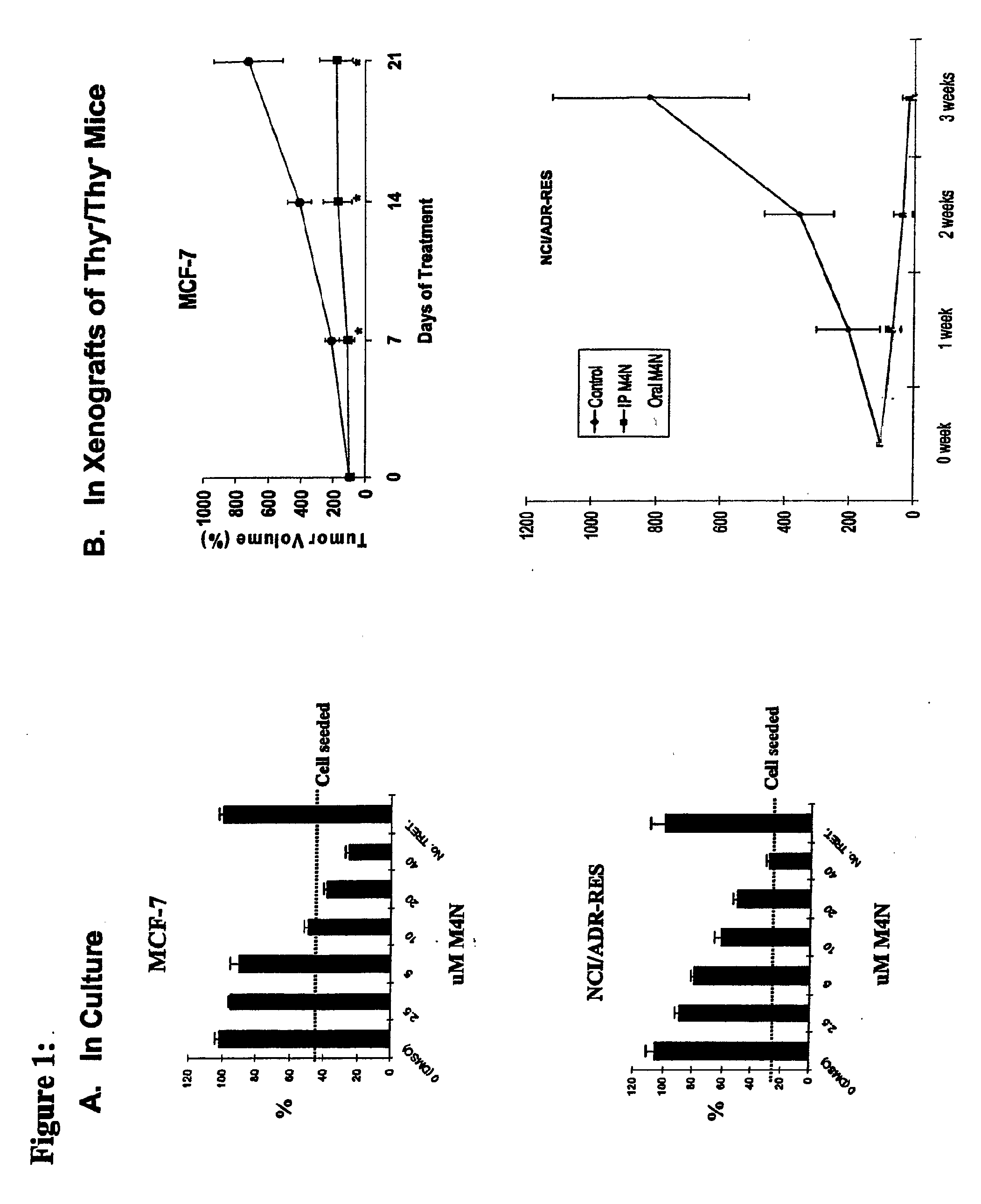Use of Nordihydroguaiaretic Acid Derivatives in the Treatment of Drug Resistant Cancer, Viral and Microbial Infection
a technology of nordihydroguaiaretic acid and derivatives, which is applied in the direction of antibacterial agents, antibiotics, drug compositions, etc., can solve problems such as drug resistan
- Summary
- Abstract
- Description
- Claims
- Application Information
AI Technical Summary
Benefits of technology
Problems solved by technology
Method used
Image
Examples
example 1
M4N Treatment Blocks Cellular Proliferation of MCF-7 and NCI / ADR Cells in Culture and in Xenografts of Thy− / Thy− Mice
Methods
[0101]MCF-7 cells (a human mammary carcinoma cell line, obtainable from the ATCC P.O. Box 1549, Manassas, Va. 20108) were seeded into 24-well plates at 1.5×104 cells / well in 500 μl of Dulbecco's modified Eagle's medium (DMEM) containing 10% fetal bovine serum (FBS) and the antibiotics penicillin and streptomycin. Varying concentrations of M4N were added the next day. After incubation for an additional 3 days, cell proliferation was assessed by the MTT assay. For the xenograft study, female athymic nude (nu / nu) mice 5-6 weeks of age were implanted subcutaneously (s.c.) in their flanks with 2×106 MCF-7 cells or 2×106 NCFADR cells (obtained from the Tumor Repository Developmental Therapeutic Program, NCI—Frederick, Md.) suspended in Hank's balanced salt solution (HBSS). When the tumors exhibited a mean diameter of 7-8 mm, the mice were fed with M4N in sterilized f...
example 2
Cdc2 and Survivin Expression are Greatly Reduced in MCF-7 and NCI / ADR Cells Following M4N Treatment
Methods
[0103]After treatment with indicated M4N concentrations, MCF-7 and NCI / ADR cell monolayers were washed with PBS and harvested with 10 mM EDTA and 10 mM EGTA in PBS. The washed cells were pelleted and lysed in RIPA Buffer (50 mM tris-HCl, pH 7.4, 150 mM NaCl, 1% Triton x-100, 1% sodium deoxycholate, 0.1% SDS and 1 mM EDTA) containing Protease Inhibitor Cocktail (Sigma Chemical Co., St. Louis, Mo.). Protein concentrations were determined with the Bio-Rad protein concentration assay solution. Twenty-five micrograms of protein were separated on a 14% SDS PAGE gel and electroblotted to a Hybond enhanced chemiluminescence (ECL) nitrocellulose membrane (Amershamn Biosciences, Piscataway, N.J.) using a semi-dry electroblot apparatus. Primary rabbit polyclonal antibodies against Cdc2 (Oncogene Research Products, cat. #D04431-1), survivin (Santa Cruz Biotechnology, Santa Cruz, Calif., cat...
example 3
M4N on Induction and Expression of MDR
Methods
Cell Culture and Drug Additions
[0105]The human breast cancer cell line, MCF-7, was obtained from ATCC. The multidrug resistant cell line, NCI / ADR-RES, was obtained from the DTP Human Tumor Cell Line Screen (Developmental Therapeutics Program, NCI). Both cell lines were maintained in Dulbecco's modified Eagle's medium supplemented with 10% fetal bovine serum and the antibiotics penicillin and streptomycin. The NDGA derivative, M4N, was synthesized as described previously (1, 13). Stocks of M4N and paclitaxel (Sigma-Aldrich, St. Louis, Mo.) were prepared in dimethyl sulfoxide (DMSO) and added to the cell culture medium so that the final concentration of DMSO was one percent. Aqueous stocks of Dox (Sigma-Aldrich) were prepared and filter sterilized before dilution into growth medium.
[0106]NCI / ADR-RES cells were seeded at a density of 2×104 cells per well in 24 well plates and 24 h later the growth medium was supplemented wi...
PUM
| Property | Measurement | Unit |
|---|---|---|
| diameter | aaaaa | aaaaa |
| concentration | aaaaa | aaaaa |
| pH | aaaaa | aaaaa |
Abstract
Description
Claims
Application Information
 Login to View More
Login to View More - R&D
- Intellectual Property
- Life Sciences
- Materials
- Tech Scout
- Unparalleled Data Quality
- Higher Quality Content
- 60% Fewer Hallucinations
Browse by: Latest US Patents, China's latest patents, Technical Efficacy Thesaurus, Application Domain, Technology Topic, Popular Technical Reports.
© 2025 PatSnap. All rights reserved.Legal|Privacy policy|Modern Slavery Act Transparency Statement|Sitemap|About US| Contact US: help@patsnap.com



